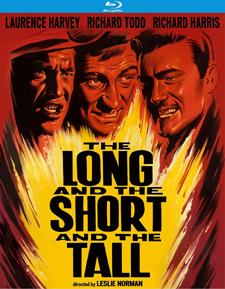Long and the Short and the Tall, The (Blu-ray Review)

Director
Leslie NormanRelease Date(s)
1961 (May 19, 2020)Studio(s)
Michael Balcon Productions/ABPC/Continental Distributing (Kino Lorber Studio Classics)- Film/Program Grade: C+
- Video Grade: B
- Audio Grade: B
- Extras Grade: D-
Review
War movies are known for lots of action with just enough characterization for audiences to form a connection and root for the good guys. Exposition is generally kept to a minimum, with visuals carrying the picture. The British World War II movie The Long and the Short and the Tall (released as Jungle Fighters in the USA and Canada) is atypical—light on action and heavy on dialogue.
In 1942, seven British soldiers in the remote jungles of Burma are on a mission to record various sounds that will be used to deceive Japanese troops. The men lose radio contact with their base and don’t know whether to move on. A Japanese scout (Kenji Takaki) wanders into their camp, they take him prisoner, and tensions escalate as their leader, Sergeant Mitchem (Richard Todd), clashes with second-in-command Corporal Johnstone (Richard Harris) and a loud-mouthed, testy Cockney, Private Bamforth (Laurence Harvey). When an ominous radio message tells them Japanese troops are in the area, the men realize they have to act.
Sergeant Mitchem believes they must bring the prisoner back to their base alive as a source of information. The others want to kill him because he threatens to reveal their location but Bamforth, who has developed a cautionary rapport with the prisoner, argues against killing him in cold blood. A good part of the film deals with this moral question as Japanese troops close in and the men must struggle with time and their own consciences.
Based on a hit London play by Willis Hall, The Long and the Short and the Tall shows off its theatrical origins in nearly every scene. Rather than using naturalistic speech, the screenplay by Wolf Mankowitz offers highflown monologues and dialogue. Instead of suggesting average British guys talking to each other amid encroaching danger, the conversation sounds crafted, polished, and often highbrow.
Director Leslie Norman misses opportunities both to open up the action and to increase suspense by not cutting often enough to the Japanese troops as they get closer to the isolated group, far outnumbering them. The jungle is so obviously a studio set that it fails to believably establish the locale. Action sequences are relegated to the film’s final act, but by then, the viewer has been bombarded with such an excess of verbiage that it fails to have the intended impact.
Laurence Harvey’s is the standout performance. His character is central to the film’s dramatic core and he has the most dialogue. Initially unpleasant and surly, his Bamforth later surprisingly reveals himself to be thoughtful with an ethical compass. This contrast between authority-hating and moral sensitivity makes him the most interesting character by far. The others, including Richard Todd’s Mitchem, are war-movie clichés. David McCallum, who would later become a heartthrob as Ilya Kuryakin on TV’s The Man From U.N.C.L.E., is Private Whitaker, the radio operator. The other team members are played by Ronald Fraser, John Meillon, and John Rees. It’s interesting to see both Harvey and Harris shortly before they made it big in Hollywood.
There’s an art to adapting a successful play to film. How do you retain the power and impact of the original while taking advantage of the cinematic possibilities to enhance it? The theatricality of The Long and the Short and the Tall and the bare minimum of action make it a war picture with missed opportunities.
The Blu-ray release from Kino Lorber Studio Classics, featuring 1080p resolution, is presented in the widescreen format of 1.66: 1. The studio sets are obvious and there’s little variation in lighting, whether the men are in the jungle or in a building they use as temporary shelter. The blocking of the actors is very much like theater staging, positioned so that all face the camera during key dialogue exchanges. The cinematography is uninspired and cannot mask the phony jungle sets.
The audio is included in English 2.0 mono DTS-HD with optional subtitles in English SDH. Dialogue is distinct throughout in this dialogue-heavy feature. There are hardly any sounds of the jungle, such as birds, wind rustling through lush foliage, or water in the nearby river.
The only bonus materials are trailers for The Train, Ambush Bay, and Juggernaut.
– Dennis Seuling

